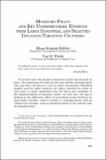| dc.contributor.author | Schmidt-Hebbel, Klaus | |
| dc.contributor.author | Walsh, Carl E. | |
| dc.date.accessioned | 2019-11-01T00:04:29Z | |
| dc.date.available | 2019-11-01T00:04:29Z | |
| dc.date.issued | 2009 | |
| dc.identifier.isbn | 978-956-7421-32-9 | |
| dc.identifier.uri | https://hdl.handle.net/20.500.12580/3753 | |
| dc.description | In recent years, the design of monetary policy has focused on gaps—the output gap, the interest rate gap, and the unemployment rate gap have all played a role in policy discussions. Standard models used for policy analysis are either specified in terms of such gaps or imply important roles for these gap variables in the implementation of monetary policy. In each case, the gap is defined as the difference (often in percentage terms) between an observable variable, such as output or unemployment, and an unobserved variable, such as potential output or the natural rate of unemployment. | |
| dc.format | .pdf | |
| dc.format.extent | Sección o Parte de un Documento | |
| dc.format.medium | p. 285-370 | |
| dc.language.iso | eng | |
| dc.publisher | Banco Central de Chile | |
| dc.relation.ispartof | Series on Central Banking, Analysis, and Economic Policies, no. 13 | |
| dc.rights | Attribution-NonCommercial-NoDerivs 3.0 Chile | * |
| dc.rights.uri | http://creativecommons.org/licenses/by-nc-nd/3.0/cl/ | * |
| dc.subject | POLÍTICA MONETARIA | es_ES |
| dc.subject | INFLACIÓN | es_ES |
| dc.subject | DESEMPLEO | es_ES |
| dc.title | Monetary policy and key unobservables: evidence from large industrial and selected inflation-targeting countries | |
| dc.type.doc | Artículo | |
| dc.file.name | BCCh-sbc-v13-p285_370 | |


